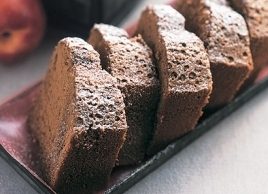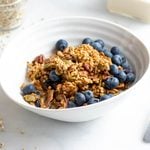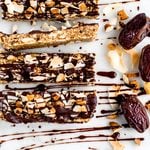Cappuccino Chiffon Cake
When chiffon cakes first appeared in the 1940s, the focus was on how easy they were to mix. Today, however, we also value the fact that they are sweet treats (such as this cappuccino chiffon cake) which are lower in fat and cholesterol than most.
Source: Cook Smart for a Healthy Heart, Reader’s Digest Canada

| Servings | Prep Time | Cook Time |
| 16slices | 15minutes | 45minutes |
| Servings | Prep Time |
| 16slices | 15minutes |
| Cook Time |
| 45minutes |
- 2 1/4 cups all-purpose flour
- 1 1/2 cups caster (superfine) sugar
- 1 tbsp baking powder
- 3/4 tsp cinnamon
- 1/2 cup walnut oil or extra-light olive oil
- 2 large eggs separated, plus 4 large egg whites
- 3/4 cup brewed espresso coffee at room temperature
- 2 tbsp cocoa powder
- 1 tsp vanilla extract
- 1/2 tsp cream of tartar
- 2 tbsp icing sugar sifted, to dust
|
Ingredients
Servings: slices
Units:
|
- Preheat the oven to 325ºF (160°C). Place the flour, sugar, baking powder and cinnamon in a medium bowl and mix. Place the oil, 2 egg yolks, coffee, cocoa powder and vanilla extract in a large bowl and beat with an electric mixer until smooth. Fold in the flour mixture with a large metal spoon.
- Place the 6 egg whites in another bowl and beat with clean beaters until frothy. Add the cream of tartar and beat until stiff peaks form. Gently fold into the cake mixture.
- Spoon the mixture into an ungreased 25 cm (10 in.) ring pan. Bake until a skewer inserted in the centre of the cake comes out clean, about 45 minutes.
- Leaving the cappuccino chiffon cake in the pan, invert it and place over the neck of a bottle to cool completely. (Cooling the cake in the pan the right way up will cause it to sink.) Run a knife around the chiffon cake to loosen it. Turn it out onto a plate and dust with icing sugar.
Per serving: 228 calories, 4 g protein, 8 g total fat, 1 g saturated fat, 31 mg cholesterol, 36 g total carbohydrate, 21 g sugars, 1 g fibre, 171 mg sodium
Walnut oil is a rich source of heart-friendly monounsaturated and polyunsaturated fats and the antioxidant vitamin E. It may help lower the risk of heart disease by increasing high-density lipoprotein (HDL), or “good,” cholesterol.




